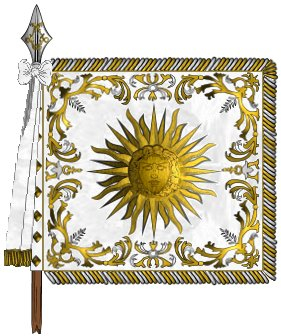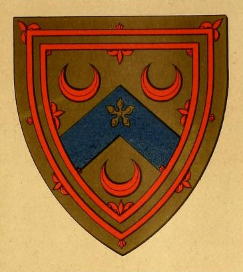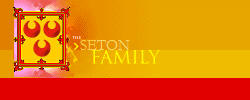|

Seton's in the 'Gardes
Ecossais' in France
The Setons had
long-standing connections with France and the Auld Alliance.
In 1419 Sir Thomas Seton and his brother each commanded a
company of men-at-arms and archers. According to William
Forbes-Leith the Seton brothers were “conspicuous amongst
the most faithful followers of the Dauphin. Thomas was
favoured with the estate of Langeais, and appointed to
accompany Charles wherever he went.” Thomas Seton was
captain of twenty seven men-at-arms and a hundred mounted
archers and was employed as bodyguard to the Dauphin
Charles, six years before the founding of the Scottish
Guard. Seton's company of 127 men-at-arms and archers can
perhaps be viewed as a precursor or progenitor of the
Scottish Guard. Thomas Seton was among the many Scots killed
during the Battle of Cravant in 1423.
Sir William Seton, the
eldest son of Sir John Seton, 2nd Lord Seton, also fought
for Charles VII, dying at the Battle of Verneuil in 1424. In
The History of the House of Seytoun by Sir Richard Maitland
there is a mention of Robert Seton, second son of George,
fourth Lord Seton, described as “ane man of armes in France”
who died at the Castle of Milan. Robert Seton's son,
William, is also described as “ane man of armes in France”
and his name appears in the 1558 muster roll of the Scottish
Men-at-arms as detailed by William Forbes-Leith.
Francisque-Michel in his
work Les Ecossais en France (1862) mentions Graham Seton as
an archer in the Scottish Guard about 1467 and George Seton
as member of the Guard in 1575. Four Setons are listed in
the Guard's muster roll for 1587 and three members of the
family are recorded in the roll of 1624.
Sir John Seton of Cariston, a cousin of the Earl of Eglinton,
had three sons, two of whom travelled to France. His second
son, also called Sir John Seton, is described as “Captain in
the Scots Guards in France, married to a daughter of the
Count of Bourbon” in George Seton's History of the Family of
Seton During Eight Centuries (1896).
Another member of the
family and namesake, Sir John Seton, was Lieutenant of the
Guard from 1632 to 1640. He is presumed to have been the son
of the aforementioned John Seton, Captain of the Guard. By
the early 17th century the Scottish Guard had ceased to be
an exclusively Scottish company, with Frenchmen making up
two thirds of the personnel. In a letter to the Marquis of
Hamilton dated 3rd of November 1634 he describes himself as
“the last Scots Lieutenant” of the Guard. Rivalries between
the Scots and the French came to the fore during this period
as William Forbes-Leith recounts in Chapter 11 of The Scots
Men-at-arms and Life-guards in France, entitled 'The Last
Kings of France – The Last Scots Guards':
Louis XIV. maintained the companies of Scots Men-at-arms and
Scots Guards, the only two corps in the French army which
had survived the troubles of the sixteenth century, and
allowed both companies to remain in possession of their
privileges. One of them was to take precedence of the whole
French army in virtue of seniority – a most precious
privilege […] It was natural that the French should murmur
at the distinctions bestowed on the strangers, and the
records of the court prove that they frequently met with
jealous opposition.
At the funeral of Louis
XIII., according to the ceremonial, the Scots Guards were to
accompany the corpse from St Germain's to St Denis, and not
to leave it till it was deposited in the Bourbon vault. When
the corpse reached St Denis, at the church door a disputed
point arose regarding the pall between the Scots Guards and
the royal footmen who had taken hold of it. The Guards
claimed their privileges, and Lieutenant Seton defended
their claim in opposition to the Prior, who was in favour of
the royal servants. The point was then referred to the
Marquis de Sainctot, Master of Ceremonies, who decided in
favour of the Guards ; however Lieutenant Seton gave ten
pistoles [gold coins] to the royal servants. The corpse was
then borne to the midst of the choir by eight Scots Guards.
In 1679 a certain David
Seton is recorded as Brigadier of the Guard. The surname
Winton appears in the muster rolls of the Guard. In Scotland
this name derives from the lands of Winton in Pencaitland,
East Lothian, held by the Seton family since the 12th
century.
The sixth Earl of
Eglinton's father, Robert Seton, Earl of Winton, and
grandfather, George Seton, both had strong ties to France.
George Seton spent his childhood in France where he was
educated. His epitaph at Seton Collegiate Church states:
"Being deprived of his most worthy father, when he was a
young man, living in France, he returned home, and in a
short time afterwards, by a decree of the Estates of the
Kingdom, he is sent back to France, and there, as one of the
Ambassadors, he negotiated and ratified the marriage between
Queen Mary and Francis, Dauphin of France, and the ancient
treaties between the French and the Scots."
George Seton married
Isabel, daughter and heiress of Sir William Hamilton of
Sanquhar, by which he acquired the Manor of Sorn and lands
in Kyle in Ayrshire. In 1583 he returned to France as
ambassador with the intention of continuing the Auld
Alliance. He was accompanied by his sons Robert Seton,
future Earl of Winton, who had been educated in France, and
Alexander Seton, future Earl of Dunfermline. While in France
Lord Seton made efforts to secure the position of Captain of
the Scottish Guards for one of his sons, Sir William Seton.
Around this time George Seton's sister, Mary Seton, one of
the 'Four Marys' who attended Mary, Queen of Scots, retired
to the Convent of Saint-Pierre in Rheims, northern France.
Mary Seton spent the remainder of her life at this convent
which was headed by Renée of Lorraine, sister of Mary of
Guise and aunt of Mary, Queen of Scots.
Portrait of George, 7th Lord Seton, and his family,
including, second from left, Robert Seton, future Earl of
Winton and father of the Earl of Eglinton. The youngest of
the sons is William Seton, who later acquired the lands of
Kylesmuir in the parish of Mauchline, Ayrshire. Sir Walter
Scott described this family portrait of the Setons as a
“very curious portrait... painted in a hard, but most
characteristic style by Sir Antonio More. The group slope
from each other like the steps of a stair, and all, from the
eldest down to the urchin of ten years old, who is reading
his lesson, have the same grave, haughty, and even grim cast
of countenance, which distinguishes the high feudal baron,
their father. […] This picture... is one of the most
celebrated monuments of art belonging to Scottish history,
and cannot be looked on without awakening the most powerful
recollection of those feudal times”.
 Arms
of the Setons of Kylesmuir. John Seton, second son of
William Seton of Kylesmuir, was described as “ane officer in
France, wher the said John dyed.” Arms
of the Setons of Kylesmuir. John Seton, second son of
William Seton of Kylesmuir, was described as “ane officer in
France, wher the said John dyed.”
Illustration of the Eglinton estate from George Seton's
History of the Family of Seton. The sixteenth century castle
visited by Mary, Queen of Scots was replaced with the
castellated mansion shown here by Hugh Montgomery, twelfth
Earl of Eglinton, soon after his accession to the Earldom in
1796. In the Dining-room of the twelfth Earls' castle there
hung a portrait of Mary Seton, one of the 'Four Marys'. A
necklace gifted to Mary Seton by Mary, Queen of Scots was
reputedly worn by the Countess of Eglinton.
Archibald Montgomerie, 13th Earl of Eglinton, acquired the
Seton Earldom of Winton in 1859. George Seton, 5th Earl of
Winton, had been stripped of the title for his adherence to
the Jacobite cause in 1715.
The historic importance of
the Eglinton line of the Seton family is discussed in A
history of the family of Seton during eight centuries by
George Seton:
The importance of this distinguished branch of the family
has been materially increased since it came to be regarded
as inheriting the representation of the House of Seton,
after the failure of the Kingston and Garleton branches in
the male line. It must be borne in mind that, like several
of the cadets who adopted other surnames, the Earls of
Eglinton, since the beginning of the seventeenth century,
though nominally Montgomeries, have been really Setons, and
hence their claim to the headship of the great historic
House of Seton.
(from the Irvine's
History Notes website) |

